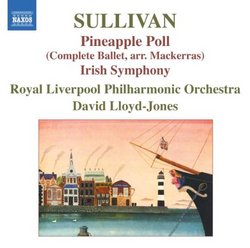A Different Arrangement of Sir Arthur Sullivan's Stage Music
Timothy Kearney | Hull, MA United States | 10/05/2007
(4 out of 5 stars)
"PINEAPPLE POLL is to Sir Arthur Sullivan as GAITE PARISIENNE is to Offenbach. Sir Charles Mackerras, early in his career took some of the music he considered most "danceable" from Gilbert and Sullivan stage works and arranged it to create a score for a ballet that had a story closely related to Pinafore. The arrangements are upbeat, as is the music of Sullivan, and for anyone who loves Gilbert and Sullivan, listening to the recording and trying to identity the operas from which they originated can be fun, and as the line notes suggest, more difficult than an aficionado might expect. David Lloyd Jones conducts the Royal Liverpool Philharmonic Orchestra in a robust manner and seems to have an appreciation of the music that is being performed.
This CD also includes one of Sullivan's more "serious" works, his early "Irish Symphony." Sullivan hoped to be a symphonist and only wrote music for the stage only as a means of earning a living. This recording seems to perform the work as well as it can be, but it's a somewhat generic piece and most likely, listeners will probably agree his stage works demonstrate his true gifts and genius, are stronger than his orchestral output, and show more originality than the "Irish Symphony." Still, it is a work that has its enjoyable moments, particularly the third and fourth movements. I would doubt that this recording will catapult it into the repertoire of most major orchestras, but it is a novelty piece to include in a music library.
"
A Modest Pitch for Sullivan's Irish Symphony
M. C. Passarella | Lawrenceville, GA | 12/31/2007
(5 out of 5 stars)
"The two reviewers on this page have praised the music of "Pineapple Poll," both Sullivan's and Mackerras's contributions. Rightly so. But they have also both dismissed Sullivan's lone symphony, so I want to make the case for it in a very modest way and will do so bye and bye.
Certainly, "Pineapple Poll" is an excellent confection in the style of "Gaite Parisienne." It may even be finer than what Manuel Rosenthal did for the music of Offenbach. Nicely stitched together from familiar and unfamiliar Sullivan (the finale, which uses the stately music from "Yeoman of the Guards" and the very balletic music from "Overture di Ballo" is a grand finale indeed) and colorfully orchestrated, it is fail-safe stuff. The Symphony, on the other hand, a hit at its premiere at the Crystal Palace in 1866, hasn't faired so well in critical or popular circles since the 19th century.
I think the main problem is the first movement, a long sonata-form affair with a too-long, slow introduction that obviously mimics the first movement of Mendelssohn's Scottish Symphony and doesn't do it well. The overall effect is rather sullen no matter what the conductor does to redeem it, lacking the tension (and fine first melody) of Mendelssohn's comparable movement. The second movement of Sullivan's Symphony, though indebted again to Mendelssohn, is pleasant enough. But the third movement, unconventional in form and with a jaunty little march theme on the oboe (giving it a properly rustic feel) instead of the typical scherzo dash of Mendelssohn or Schumann, has elicited praise from the get-go. And the last movement, the real Irish payoff, does something that many Romantic composers fail to do in their symphonic finales: keep things moving. It has not only a couple of very nice folk-like melodies but a pretty good working out of same, and Sullivan builds real momentum before a big coda, with dissonant brass comments, that reminds me of the coda of Dvorak's Fifth Symphony, written about nine years later.
So if you give the Irish Symphony a chance, it does have something to say, especially at the close. This reading from Lloyd-Jones and the Royal Liverpool has all the requisite elan in the finale and makes all the right moves elsewhere, capturing very nicely the Victorian high-mindedness and high-spiritedness of the score. The engineering is typical of the excellent work Naxos does in the British Isles. Altogether, I find this an entertaining presentation of both pieces and will return to the Symphony as often as to the ballet."

